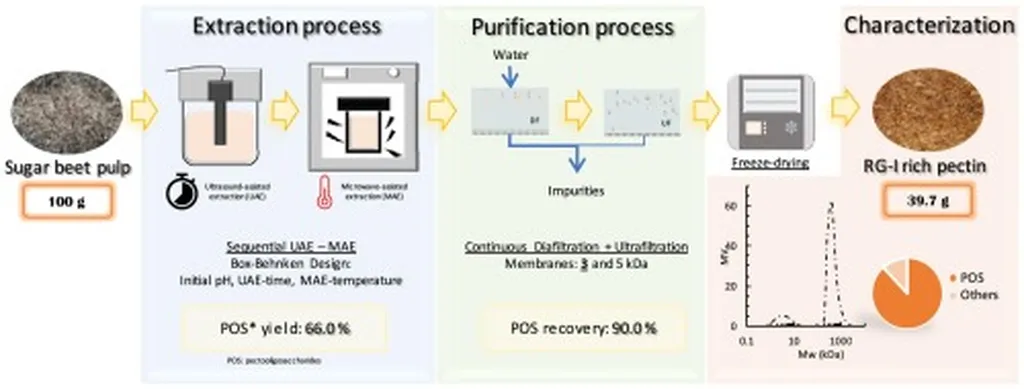In the quest for sustainable and economically viable solutions, researchers are turning to agricultural byproducts to unlock hidden value. A recent study led by Xinmeng Huang from the College of Smart Agriculture at Xinjiang University has shed light on how different drying techniques can significantly impact the quality of soluble dietary fiber (SDF) derived from sugar beet pulp (SBP), a byproduct of the sugar industry. The findings, published in the journal *Foods* (which translates to “Foods” in English), could have profound implications for the food and energy sectors.
Sugar beet pulp is a rich source of fiber, with its soluble dietary fiber component being particularly valuable. The initial step in processing this fiber involves drying the fresh pulp. Huang and his team compared the effects of hot air drying and microwave drying on the composition, structure, and physicochemical properties of SDF in SBP. Using advanced technologies such as gel permeation chromatography, gas chromatography–mass spectrometry, Fourier transform infrared spectroscopy, scanning electron microscopy, and Zeta potential analysis, the researchers uncovered striking differences between the two drying methods.
Microwave drying was found to enhance the sugar components in SDF, reduce polysaccharide molecular weight, and create a uniform and porous microstructure. This resulted in a higher Zeta potential (−24.76 mV) and increased water holding capacity (5.01 g/g). “Microwave drying not only preserves the nutritional value but also enhances certain properties that make the fiber more functional,” Huang explained. On the other hand, hot air drying preserved a more intact cell wall network, exhibiting higher swelling capacity (5.18 mL/g).
The study highlights how the choice of drying method can differentially regulate the quality of SDF from sugar beet pulp. This insight is crucial for industries looking to maximize the value of their byproducts. “Understanding these differences allows us to tailor the drying process to specific applications, whether it’s for food additives, dietary supplements, or even bioenergy production,” Huang added.
The implications for the energy sector are particularly noteworthy. As the world seeks sustainable energy sources, bioenergy derived from agricultural byproducts like sugar beet pulp could play a significant role. The enhanced properties of microwave-dried SDF could make it more suitable for certain bioenergy applications, while the intact cell wall structure of hot air-dried SDF might be better suited for others. This research paves the way for more efficient and sustainable utilization of agricultural waste, contributing to a circular economy.
As the global demand for sustainable and nutritious food ingredients continues to grow, the findings from this study offer valuable insights for the food industry. By optimizing the drying process, manufacturers can produce higher-quality dietary fiber products that meet the evolving needs of consumers. The research also underscores the importance of investing in advanced drying technologies to unlock the full potential of agricultural byproducts.
In conclusion, the study by Huang and his team not only advances our understanding of the impact of drying methods on soluble dietary fiber but also opens up new possibilities for the food and energy sectors. As the world moves towards more sustainable practices, such innovations will be crucial in shaping the future of agriculture and bioenergy.

